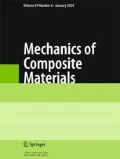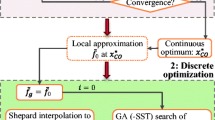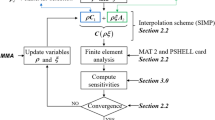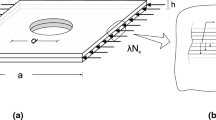The present study aims to design stacking sequences of dimensionally stable symmetric balanced laminated carbon/epoxy composites, with different numbers of layers, with a low coefficient of thermal expansion and high elastic moduli. To avoid excessive interlaminar stresses in the composites, the contiguity constraint for plies is also taken into consideration. In the design process, both single- and multiobjective optimization approaches, including genetic algorithms, are utilized. Results showed that stacking sequences ensuring lower thermal expansion coefficients and higher elastic moduli than those of traditional laminate designs can be obtained.




Similar content being viewed by others
References
W. Wang, S. Gou, N. Chang, and W. Yang, “Optimum buckling design of composite stiffened panels using ant colony algorithm,” Compos. Struct., 92, 712-719 (2010).
L. Aydin and H. S. Artem, “Comparison of stochastic search optimization algorithms for the laminated composites under mechanical and hygrothermal loadings,” J. Reinf. Plast. Comp., 30, No. 14, 1197-1212 (2011).
F. Bressan, F. De Bona, and A. Soma, “Design of composite laminates with low thermal Expansion,” Proc. Instn. Mech. Engrs., Part L: J. Materials: Design and Applications, 218, 201-209 (2004).
A. Rangarajan, J. D’Mello, V. Sundararaghavan, and A. M. Waas, “Minimization of thermal expansion of symmetric, balanced, angle ply laminates by optimization of fiber path configurations,” Compos. Sci. Technol., 71, 1105-1109 (2011).
L. N. McCartney and A. Kelly, “Effective thermal and elastic properties of [+θ/−θ]s laminates,” Compos. Sci. Technol., 67, No. 3-4, 646-661 (2007).
S. S. Rao, Engineering Optimization: Theory and Practice, 4 ed., John Wiley & Sons, Hoboken—New Jersey (2009).
Z. Gurdal, R. T. Haftka, and P. Hajela, Design and Optimization of Laminated Composite Materials, John Wiley & Sons, New York—Chichester—Weinheim—Brisbane—Singapore—Toronto (1999).
K. K. Sairajan and P. S. Nair, “Design of low mass dimensionally stable composite base structure for a spacecraft,” Compos., Part B, Eng., 42, 280-288 (2011).
Z. Zhang, W. Zhong, and H. Song, “Design of hybrid composites with zero coefficient of thermal expansion,” J. Mater. Sci. Technol., 12, 241-248 (1996).
L. Aydin, O. Aydin, H. S. Artem, and A. Mert, “Design of dimensionally stable composites using efficient global optimization method,” Proc. I. Mech. E, Part L: J. Materials: Design and Applications, 233, No. 2, 156-168 (2019).
R. A. Haynes and E. A. Armanios, “The challenge of achieving hygrothermal stability in composite laminates with optimal couplings,” Int. J. Eng. Sci., 3, 1-9 (2012).
J. Li and D. Li, “Extension-shear coupled laminates with immunity to hygro-thermal shearing distortion,” Compos. Struct., 123, 401-407 (2015).
C. B. York, “On extension-shearing coupled laminates,” Compos. Struct., 120, 472-482 (2015).
D. Cui and D. Li, “Optimization of extension-shear coupled laminates based on Differential Evolution algorithm,” Mech. Compos. Mater., 54, No. 6, 799-814 (2019).
D. Cui and D. Li, “Bending-twisting coupled structures based on composite laminates with extension-shear coupling effect,” Compos. Struct., 209, No. 1, 434-442 (2019).
The Mathworks, Inc. MATLAB computer software in version R2008b.
A. K. Kaw, Mechanics of Composite Materials, 2 ed., CRC Press Taylor & Francis Group, Boca Raton—London—New York (2006).
J. L. Pelletier and S. S. Vel, “Multiobjective optimization of fiber reinforced composite laminates for strength, stiffness and minimal mass,” Comput. Struct., 84, 2065-2080 (2006).
M. Gen and R. Cheng, Genetic Algorithms and Engineering Optimization, John Wiley & Sons, New York—Chichester—Weinheim—Brisbane—Singapore—Toronto (2000).
K. Deb, A. Pratap, S. Agarwal, and T. Meyarivan, “A Fast and Elitist Multiobjective Genetic Algorithm: NSGA-II,” IEEE Trans. Evol. Comput., 6, No. 2, 182-197 (2002).
A. Kamaloo, M. Jabbari, M. Y. Tooski, and M. Javadi, “Optimization of thickness and delamination growth in composite laminates under multi-axial fatigue loading using NSGA-II,” Compos., Part B, Eng., 174, 106936 (2019).
N. Srinivas and K. Deb, “Multiobjective function optimization using nondominated sorting genetic algorithms,” Evol. Comput., 2, No. 3, 221-248 (1995).
S. Qu, J. Zhao, and T. Wang, “Experimental study and machining parameter optimization in milling thin-walled plates based on NSGA-II,” Int. J. Adv. Manuf. Technol., 89, 2399-2409 (2017).
R. Ilka, Y. Alinejad-Beromi, and H. Yaghobi, “Cogging torque reduction of permanent magnet synchronous motor using multiobjective optimization,” Math. Comput. Simulat., 153, 83-95 (2018).
N. S. Hamzehkolaei, M. Miri, and M. Rashki, “New simulation-based frameworks for multiobjective reliability-based design optimization of structures,” Appl. Math. Model., 62, 1-20 (2018).
L. Aydin and H. S. Artem, “Multiobjective genetic algorithm optimization of the composite laminates as a satellite structure material for coefficient of thermal expansion and elastic modulus,” 4th International Conference on Recent Advances in Space Technologies, RAST ’09, Istanbul, 11–13 June 2009, 114-119.
R. Le Riche and J. Gaudin, “Design of dimensionally stable composites by evolutionary optimization,” Compos. Struct., 41, No. 2, 97-111 (1998).
Author information
Authors and Affiliations
Corresponding author
Additional information
Russian translation published in Mekhanika Kompozitnykh Materialov, Vol. 57, No. 3, pp. 457-480, May-June, 2021.
Rights and permissions
About this article
Cite this article
Aydin, L., Artem, H.S. & Deveci, H.A. Single- and Multiobjective Optimizations of Dimensionally Stable Composites Using Genetic Algorithms. Mech Compos Mater 57, 321–336 (2021). https://doi.org/10.1007/s11029-021-09957-y
Received:
Revised:
Published:
Issue Date:
DOI: https://doi.org/10.1007/s11029-021-09957-y




